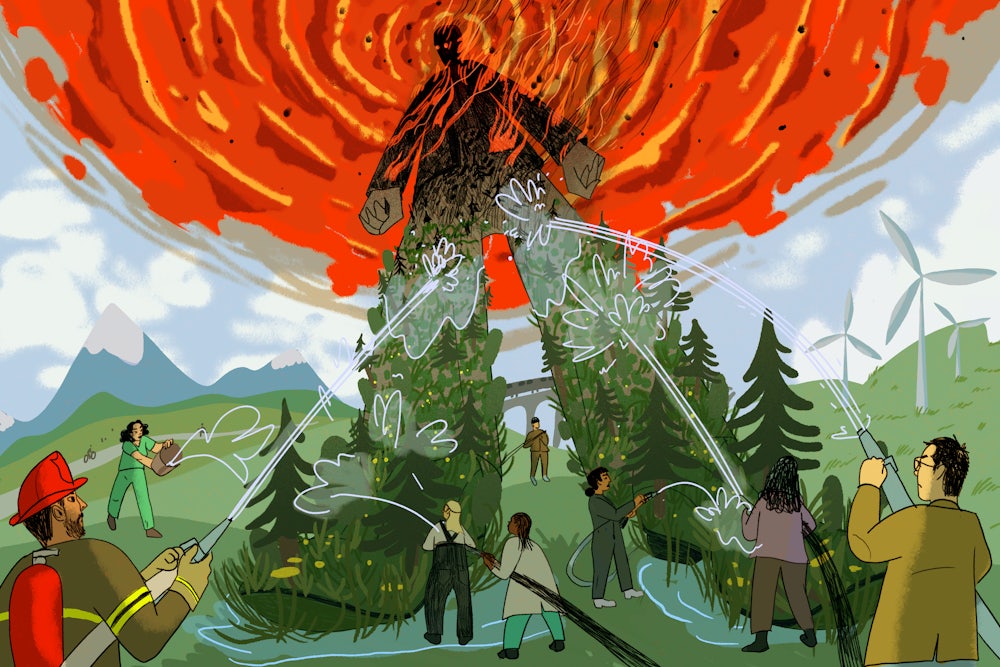By 1961, Charles Koch had stacked up three engineering degrees and was back home in Wichita, Kansas, to join the family business of oil refining, pipelines, and manufacturing. His father, Fred, was at the time attempting to tackle a different sort of engineering challenge: how to get unions, Communists, and big government off his back. The Nazi sympathizer Koch patriarch fought against unions in Kansas, and when the John Birch Society convened its inaugural meeting in 1958—initially composed exclusively of National Association of Manufacturers members—he enthusiastically attended as a co-founder. According to a 1961 Washington Post profile of Koch’s white supremacist conspiracy-theory club, “leadership of the Birch Society overlaps heavily with the leadership of the organizations that successfully campaigned in 1958 for a right to work amendment to the State’s Constitution.” Fred died in 1967, but Charles eagerly put his education to work carrying on his family’s 60-year war against collective bargaining rights and that pesky concept known as representative democracy. When it comes to right to work, especially, labor and climate campaigners quite literally share a common enemy.
If those two groups have found it difficult to join forces, their adversaries are elegantly streamlined. During the Obama administration, Koch Industries trained its fossil fuel empire on the twin goals of turning legislatures red and pushing through deceptively named right-to-work statutes, all the while finding time to help kill federal climate legislation. Though no state had enacted right-to-work rules since Oklahoma in 2001, five have taken them up since 2012. This most recent push has focused on sapping public-sector workers’ collective bargaining rights, in particular, like the bill that led thousands of union members to peacefully occupy Wisconsin’s capitol dome in 2011.
That some of the most high-profile targets of anti-labor measures have been swing states with strong union legacies—namely, Wisconsin, Ohio, and Michigan—is no coincidence. As E.J. Dionne pointed out after Michigan enacted its right-to-work measures in 2013, Obama had won 66 percent of the state’s union households a year earlier. He won the state overall by just 1 percent. In 2018, the right’s biggest win against unions came with the decision in Janus v. AFSCME, which made right to work the national standard for public-sector workers. The crux of that case was AFSCME member Mark Janus’s argument—in a case supported enthusiastically by Koch networks—that being forced to pay agency fees—which cover the costs of union representation and contract negotiation—violated his free speech. This was a major blow to unions’ capacity to extract gains from employers, weakening labor’s power overall. That’s the whole point.
For Charles Koch and other captains of industry, the calculation behind crushing unions isn’t complicated: Weaker unions mean a weaker opposition to right-wing policies, including the sort of regressive climate and energy measures they’ve helped push around the country through the American Legislative Exchange Council. The right’s general project of minority rule—whether in weakening small-d democratic institutions like unions, gerrymandering congressional districts, or suppressing votes—is incompatible with climate action and democracy itself. Big business has long understood this.
Even with Democrats now in control of the House, Senate, and White House, democratic reforms from abolishing the filibuster to a campaign finance overhaul are a prerequisite to delivering meaningful legislation. Changing laws that disempower unions should be considered among them, and climate activists joining such fights could overcome the tired and false tension between good jobs and a livable planet by going up against common enemies and ensuring green jobs can be good jobs, too. They might just salvage hopes for the United States to become a multiracial democracy in the process.
In Virginia—the worst state in the U.S. to work—Democratic lawmakers are now attempting to strike a modest blow to the GOP’s long-running offensive against majority rule by repealing its almost 75-year-old right-to-work statute. House of Delegates member and gubernatorial candidate Lee Carter introduced a bill in 2019 and again late last year as HB 1755. As he told me, “[Right-to-work laws] have nothing to do with whether or not you have a job. They force unions to bargain for people who contribute nothing.”
Virginia’s right-to-work law was enacted in 1947 after IBEW workers at the Virginia Electric and Power Company—now Dominion Energy—threatened to strike. In response, Governor William Tuck, a staunch segregationist, preemptively took over the mines and drafted its workers into an “unorganized militia,” threatening court martials should they refuse to work.
The strike never happened, but right to work was put in place shortly thereafter. Its passage took place against the backdrop of a little-remembered labor uprising that followed the Second World War. The high production and labor peace enforced through World War II had given way to the economic shock of transitioning to a peacetime economy. Months after V-J Day, the United Auto Workers walked out, sparking a wave of strikes across industries including electricity, coal, and oil. At the height of strikes in 1945, 1.6 million workers had joined a picket, historian Jeremy Brecher writes in his book Strike! Nearly three million workers were involved in strikes that began in the first six months of 1946, which, Brecher notes, the Bureau of Labor Statistics called “the most concentrated period of labor-management strife in the country’s history.”
It was around the same time that the Congress of Industrial Organizations unleashed $1 million and 250 organizers onto the Jim Crow South to “organize the unorganized” into integrated unions there as part of an effort known as Operation Dixie. Employers across the South had long relied on racism as a means to cleave workers, including against organizing drives in coal mines and steel mills by outfits like the Alabama chapter of the Communist Party, as historian Robin D.G. Kelley detailed in Hammer and Hoe. “Company police used violence and intimidation in an effort to crush Mine Mill before it could establish a following,” Kelley writes of one such drive, “but when these tactics failed, officials exploited racial animosities.”
The mine operator, TCI, created a company union, “which used racist and anti-Communist slogans to appeal to white workers.” As Kelley notes, “the cry of social equality, with all its multiple (specifically sexual) meanings and apparent ambiguities, was particularly effective” against labor organizers and the left in Alabama “because it symbolized the ultimate threat to white supremacy, class power, civilization, and Southern rulers’ most precious property—white women.” By bringing in Black strikebreakers and leaning on local law enforcement and the Ku Klux Klan, mine operators pitted diverse workforces against one another to beat back solidarity and preserve their own power. One flyer sent out to Operation Dixie organizers in the South picked up the same tactics, with a Klansman on horseback warning that “white Supremacy must be maintained.”
In reaction to both Operation Dixie and the postwar strike wave, the Taft-Hartley Act—written with heavy input from the National Association of Manufacturers—weakened the National Labor Relations Act with overwhelming support from segregationist Southern Democrats, more than 80 percent of whom supported its 1947 passage. At its core was an attack on the New Deal order that corporations had been eager for since Roosevelt first took office and knitted together a durable coalition of (among others) union members and Black voters who fled the Republican Party in droves throughout the 1930s.
The law effectively established a states-rights framework for labor law, forbade industry-wide collective bargaining, and cut off several avenues for unions to engage in politics. It further required union officials to sign a pledge that they were not members of the Communist Party. With the NLRA neutered, states south of the Mason Dixon line would become testing grounds for right-to-work rules. They were the brainchild of the Houston oil lobbyist Vance Muse, who described the benefits he saw in such statutes bluntly: “From now on, white women and white men will be forced into organizations with black African apes whom they will have to call ‘brother’ or lose their jobs.” “These laws were designed in the 1940s to stoke tensions between white workers and Black workers,” Carter explained. “The subtext was right to work without integration.”
That carbon-intensive industries like coal, steel, and electricity were so central to the U.S. economy and such prime targets for labor actions made it especially important for industry and politicians to keep them running profitably and without disruption, by any means necessary. As recently as the 1970s, miners engaged in militant, multiracial battles against their bosses. That the same workers are now seen as the centerpiece of Trumpist white identity politics—and a cudgel against climate policy—is both a historical novelty and the product of a decades-long fight to drive unions and solidarity alike out of the industries that keep the country running.
Today, a new generation of Southern Democrats in Virginia have been wary of repealing its right-to-work law. Governor Ralph Northam and several other Democrats refused to back the repeal effort when it was first raised in 2019, when the Republican Party controlled Richmond. One common pushback Carter got then was that Republican delegates would exploit the opportunity to kill right to work in a floor vote. Now they say it threatens to make the state less welcoming to big business. “When it comes to repealing right to work,” Carter said, “there’s been no functional difference between Republicans in control and Democrats in control.”
There may be cause for optimism at the national level, though. The Protecting the Right to Organize Act—which passed out of the House last February, and which Biden has voiced support for—would preempt the core of statewide right-to-work measures. In addition to a host of other workplace protections, the legislation would allow employers and unions to agree on a “fair share” clause, so that workers can pay the agency fees toward the cost of bargaining and administering collective bargaining agreements. It protects workers’ First Amendment rights, as well, like their ability to engage in the “secondary boycotts”—protesting nonunion shops, for instance—that Taft-Hartley outlawed. The PRO Act, of course, will face the same anti-democratic hurdles that threaten most progressive legislation in the Senate.
If passed, it may help build the power necessary to win green policies: A 2018 study by political scientists James Feigenbaum, Alexander Hertel-Fernandez, and Vanessa Williamson compared counties on either side of state borders—one in a state that had enacted right-to-work laws and one that hadn’t. “After the passage of RTW laws, county-level Democratic vote shares in presidential elections fall by 3.5 percentage points relative to bordering counties without RTW laws in place,” they found. “Presidential-level turnout is also 2 to 3 percentage points lower” in right-to-work counties, and such laws “generally reduce Democratic vote share and turnout in U.S. Senate and House elections, as well as state Gubernatorial races. Democratic seat shares in state legislatures also fall after the passage of RTW laws.”
For climate activists, there is ample cause to want strong unions besides needing more Democrats to pass climate legislation. The war mobilization is a frequent reference point for Green New Deal advocates. Even the Biden administration appeals to the nostalgia of a booming manufacturing economy in describing plans to produce American-made electric vehicles, for instance. The automakers who might carry that out, though, have moved many of their operations South over the last several decades, in search of weaker labor laws and cheaper wages—or out of the country entirely.
If booming electric car production were the tip of the spear of a green recovery—and there are myriad reasons to be wary of that—much of that production could well happen in nonunion plants that are hardly delivering the sort of midcentury imaginary that talk of a wartime production evokes. The country’s most high-profile electric car manufacturer, Tesla, is run by an anti-union zealot who has already violated the National Labor Relations Act. “A lot of people lament the loss of manufacturing jobs, but the truth is you can have a good union job in any industry as long as you unionize it,” Carter said. “By repealing right to work, we’re setting conditions that make it easier for organized labor to come together and form unions and demand the kind of wages” and working conditions associated with those jobs.
Taking the Green New Deal’s namesake seriously would mean not just big spending programs and curbing corporate power but proactively building electoral coalitions that can endure through the years of work that decarbonization will entail. Climate politics have often been felled by industry talking points pitting working people against environmentalists supposedly asking them to give up their livelihoods. That argument is most often made in bad faith.
Even more progressive climate policy plans, though, can make unions sound like one item on a long laundry list of good things it would be nice to have in an energy transition. In right-to-work states, especially, unionized fossil fuel work—at power plants and refineries, for instance—is frequently one of the only steady sources of well-paid jobs. Organizing for the PRO Act and right-to-work repeal could be a way for greens to show concrete solidarity with labor in the near term, building the kind of power needed to make any massive green jobs program a reality. Importantly, unions organizing the many unorganized workers in low-carbon sectors—from energy efficiency to rooftop solar—could swell their ranks and institutional power, which can bear dividends on everything from democratic reforms to labor protections to climate measures.
Where the Industrial Workers of the World sought to organize the world’s workers into “one big union,” the right’s vision is unity among a tiny ruling elite. The idea of multiracial majorities running governments is inherently threatening to the likes of Charles Koch, however much he claims to want to “unite a diversity of people behind a common goal.” His ilk has always needed to find a way to divide the masses against themselves. White supremacy has been its most powerful tool for doing so. That battles for racial justice and workplace protections and climate justice and democratic reform today seem siloed off from one another speaks to just how effective those efforts have been.
Republican presidential candidates have won the popular vote just once in the last 32 years. The party knows its governing days are numbered and is now in open revolt against the prospect of majority rule. The challenge for anyone interested in a twenty-first-century multiracial democracy is to destroy Republicans’ minoritarian project before it can destroy the planet.








